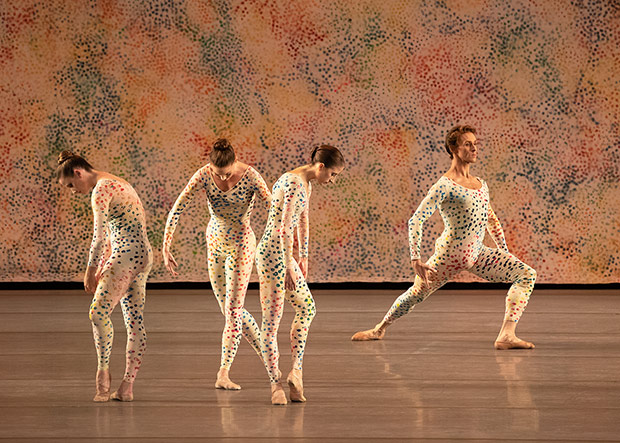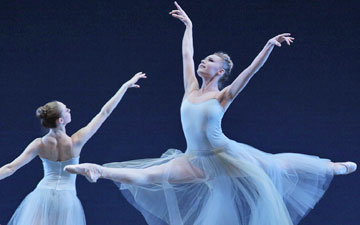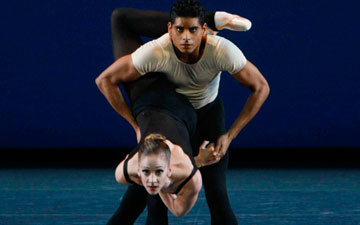
© Erin Baiano. (Click image for larger version)
New York City Ballet
Serenade, Summerspace, Tchaikovsky Piano Concerto No. 2
★★★★✰
New York, David H. Koch Theater
12 October 2019
www.nycballet.com
davidhkochtheater.com
In a Garden
On the penultimate day of the fall season, I managed to catch a performance of New York City Ballet’s revival of Merce Cunningham’s Summerspace. The 1958 piece, which had its City Ballet premiere in 1966, was last performed here in 2000. It is one of Cunningham’s most recognizable works, chiefly due to the pointillist backdrop by Robert Rauschenberg, a field of colored dots that creates the illusion of an idyllic space, like the Garden of Eden. The dancers, with their similarly-spotted unitards, blend harmoniously into the background. If only the floor were covered in the same pattern, the entire space could become a sea of color.
The score, by Morton Feldman, is also impressionistic, little splashes of notes for piano and flute that flutter through the air like butterflies. The six dancers too, come and go, semi-avian creatures following distinct paths that occasionally intersect. The impression is not one of randomness but rather of individual action – each dancer does his or her own thing, only vaguely aware of the others. Cunningham wrote that in Summerspace he sought to evoke “the passage of birds, stopping for moments on the ground, and going on.” At one point, a dancer (Abi Stafford) does a series of steps, each time lowering herself to the floor in an avian pose, head alert and one leg raised behind her, like the tail of a swallow. Then she rises up and does a few more steps, before lowering herself again, perching there for just a moment.

© Erin Baiano. (Click image for larger version)
Like all Cunningham dances, Summerspace is meticulously composed – he may have used chance to help expand his choices, but the final product was anything but random. Watching closely, one begins to make out recurring steps that echo from dancer to dancer. Hopping turns in arabesque; funny Giselle arms, waving into the wind; a tilted arabesque that morphs into a long balance in attitude to the front. Some of the images stand out for their particular beauty or dramatic import, like a long, drawn out phrase, in which Emilie Gerrity slowly crosses her legs, slides into a deep lunge, bows forward, and then maneuvers herself into a forward-facing lunge, torso twisted extravagantly. The sequence is both mesmerizing and weirdly beautiful. In another, Lydia Wellington very carefully, emphatically, steps over Gerrity’s leg; the action is impersonal, but monumental. There is a body blocking my path; what shall I do? There are little jokes too – people often overlook Cunningham’s wit – as when Andrew Veyette seems to chase after Lydia Wellington and finally catches her, placing his hands on her shoulders.
It’s always an adjustment to see Cunningham performed by ballet dancers. Inevitably, they lack the weightedness of modern dancers; by training, they don’t push into the floor, but rather away from it. Of the six who performed it this season, Lydia Wellington was the most convincing in this respect; she was able to relax her body enough to allow it to appear firmly planted on the ground. More generally, the dancers’ arms and fingers were a touch dainty, lacking the plainness of the Cunningham stance. They tend to look up, rather than out. But now that there is no longer a Cunningham Company to set the standard, each company is more free to interpret the steps through the lens of its own technique. The differences are interesting. The City Ballet dancers, with their clean Balanchine technique, have the benefit of speed and articulated footwork; they are also used to creating beautiful shapes that reverberate through space. (Andrew Veyette, whose dancing these past seasons has looked effortful, is the exception to the rule.) Images that stood out: Emilie Gerrity balancing on one foot, while the other leg extends to the side, her body lithe and expansive, betraying no sign of tension or strain; Adrian Danchig-Waring hurtling through the air in a series of stag jumps; Lydia Wellington squatting low to the ground while moving her arms in a “wiping” motion, as if grooming her wings.

© Paul Kolnik. (Click image for larger version)
Summerspace was the centerpiece in a program otherwise dominated by Balanchine. In Serenade, Gerrity gave a remarkably swift, swooning rendition of the Dark Angel role, her back pliant, her dancing windswept and distilled. Tchaikovsky Piano Concerto No. 2, the closer, started out ragged but eventually found its center, led by a joyful, electric Sara Mearns. Russell Janzen was particularly moving in the second movement, in which he leads the corps in a series of wave-like motions – the dancers become extensions of his arms, ribbons flowing across the stage. He was a rapt partner to Mearns, who was dancing with her usual space-devouring force and freedom. Eventually, she melted away into the corps, leaving Janzen alone once more. Bereft, he looked toward the corps, who turned their faces away – a touching moment of loss before the explosion of the final movement. Sadly the fussy new costumes, by Marc Happel, do not improve with multiple viewings.

© Erin Baiano. (Click image for larger version)
Tucked between these two Balanchine powerhouse ballets, Summerspace nevertheless stood its ground, creating an island of tranquility, focus, and pastoral bliss. Let’s hope it stays around for a while.

















You must be logged in to post a comment.